Coriandrum sativum
Cilantro enhances many a meal with its zesty, pungent flavor – and it can brighten up your garden too.
Also known as fresh coriander, this culinary herb is easy to grow from seed, and a homegrown supply will delight palates – and local pollinators!
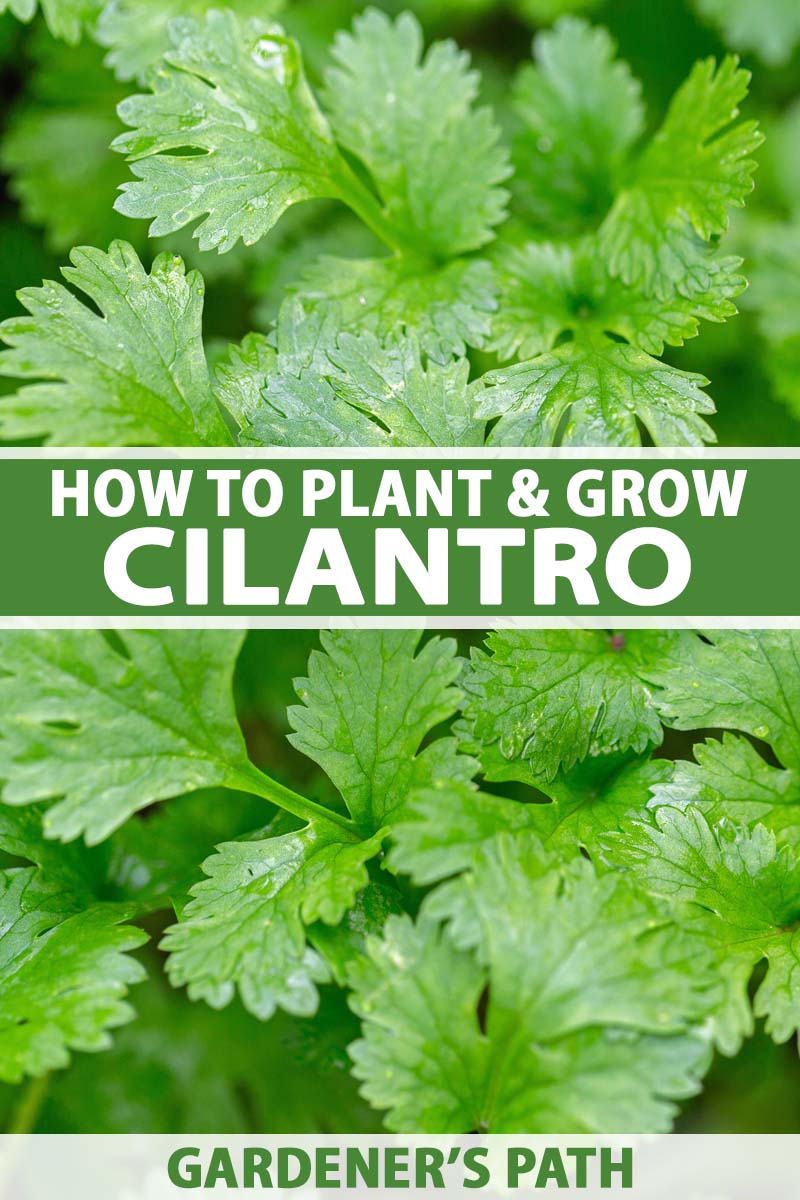
We link to vendors to help you find relevant products. If you buy from one of our links, we may earn a commission.
I like to think of cilantro as the goddess of the garden. For me, she’s always there, always ready to share – both with me, and my friendly garden pollinators.
So I guess you could say I’m a cilantro worshiper of sorts, and I’m guessing I’m not the only one!
In this article we’ll cover everything you’ll need to know about growing this divine herb.
We’ll even provide harvesting, storage, and preserving tips, as well as tantalizing your taste buds with some delectable cooking ideas.
We’ll touch on the divisiveness of this culinary ingredient as well since, as you probably know, as much as it is loved by some, cilantro is also reviled by many who experience its flavor differently.
Ready to get up close and personal with this distinctive garden herb? Let’s dig in!
What You’ll Learn
What is Cilantro?
A member of the Apiaceae family, Coriandrum sativum is related to many other stars of the herb and spice rack, such as parsley, chervil, dill, anise, caraway, cumin, and asafetida.
It’s also related to carrots, celery, celeriac, parsnips, lovage, angelica, and queen Anne’s lace.
C. sativum is an herbaceous annual plant whose leaves and seeds are enjoyed culinarily. The leaves, known in some parts of the world as cilantro, are used as an herb while the seeds, known as coriander, are used as a spice.
Even cilantro’s roots, stems, and flowers are edible!
Plants have a mounding growth habit, and generally reach 12 to 18 inches tall, with flower stalks bringing them to a total height of two to three feet. These plants also have a spread of 12 to 18 inches.
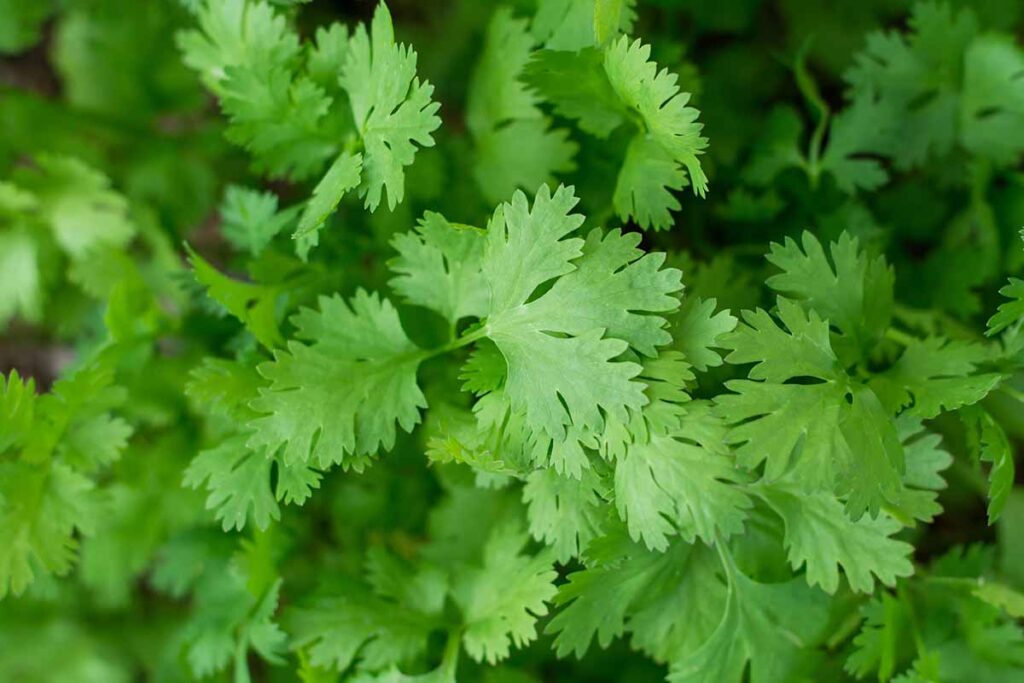
The lower leaves of this herb – the ones valued for cooking – look similar to those of parsley.
Coriander leaves are lobed, usually with deeply cut margins.
Plants produce umbrella-shaped inflorescences with small, individual flowers that are white to pale pink.

When a coriander flower stalk is growing, upper leaves appear which are wispier than the lower leaves, and these are not as desirable for cooking.
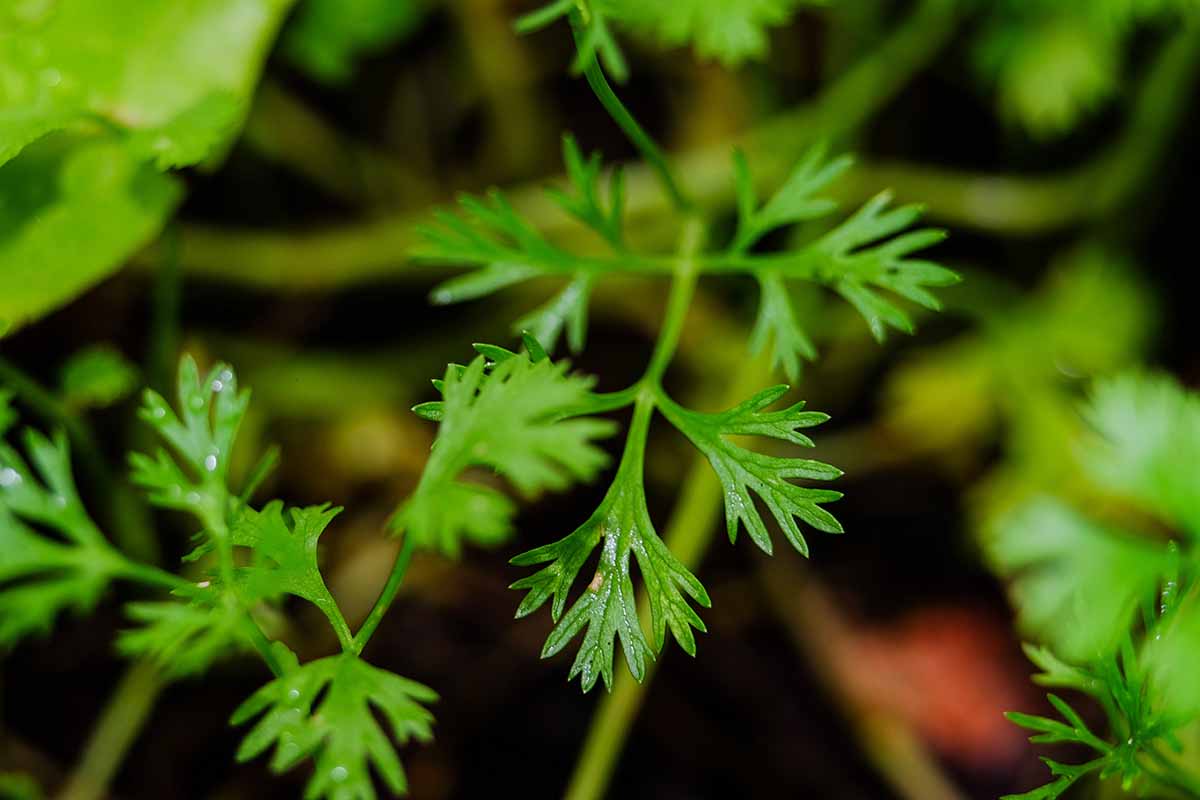
If you’re looking at this plant or considering the descriptions of it and thinking, “that’s not the cilantro I was looking for,” there are a couple of other plants that can be confused with the subject of our article.
Vietnamese coriander (Persicaria odorata), a plant that has long pointed leaves rather than frilly ones, has a similar flavor profile as fresh coriander but it is spicier.
And another plant, Eryngium foetidum, known as “culantro” (and no, that’s not a typo!) tastes very much like cilantro but has long, narrow leaves with serrated edges.
Cultivation and History
Native to Pakistan, the Mediterranean, and the Middle East, C. sativum has a long history as both a food and an herbal medicine.
Perhaps the oldest evidence of its use by humans, coriander seeds dating to 8,000 years ago were found in Nahal Hemar, an archeological cave site in Israel.
They were also found in the tomb of Tutankhamun, a pharaoh of ancient Egypt, as well as in other ancient Egyptian graves.
Winding its way through history, this plant was mentioned by classical Greek authors such as the ancient Greek physician, Hippocrates, and has been used medicinally since at least 1550 BCE.

When it comes to cuisine, in the United States the leaves of this plant are usually called “cilantro,” but in other parts of the world they may also be referred to as “Chinese parsley,” “Mexican parsley,” “fresh coriander,” or “coriander leaves.”
Cherished for their distinct flavor, cilantro leaves are featured in Levantine, Latin American, and Asian cooking.
Coriander leaves have a pungent, bright flavor that contrasts beautifully with earthy flavors like beans – at least, for those of us who love it, it does. (For those who don’t, the leaves may taste like soap.)
The seeds of the plant, commonly called coriander, are used whole or ground in many cuisines, particularly those of India, while the roots are incorporated into some Thai and Vietnamese dishes.
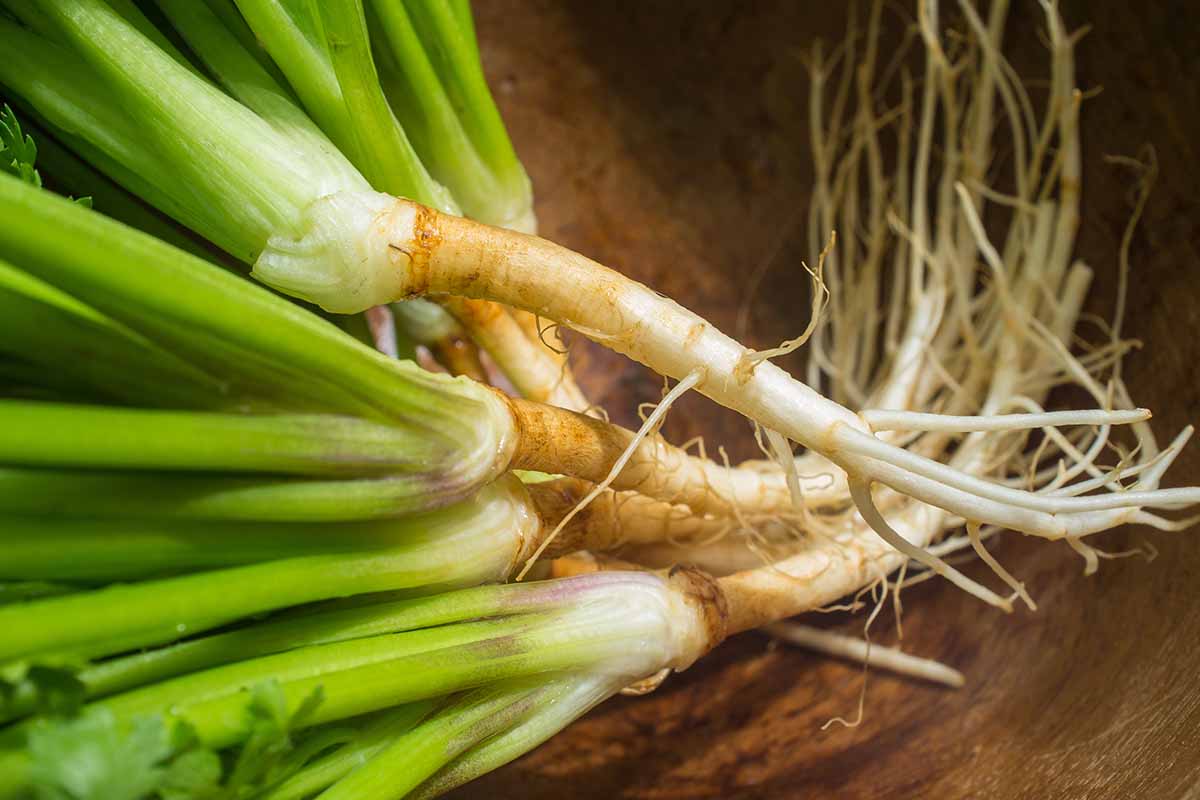
As for its use in herbal medicine, essential oils from the coriander plant exhibit antioxidant, antibacterial, and antifungal properties. This plant even shows potential for assisting in the treatment of cancer.
Research exploring the potential health benefits of various forms of coriander is ongoing, but at the very least, adding fresh and dried herbs and spices to your food is a great way to add flavor to your culinary creations and variety to your diet.
And what better way to do this than growing them in your own garden?
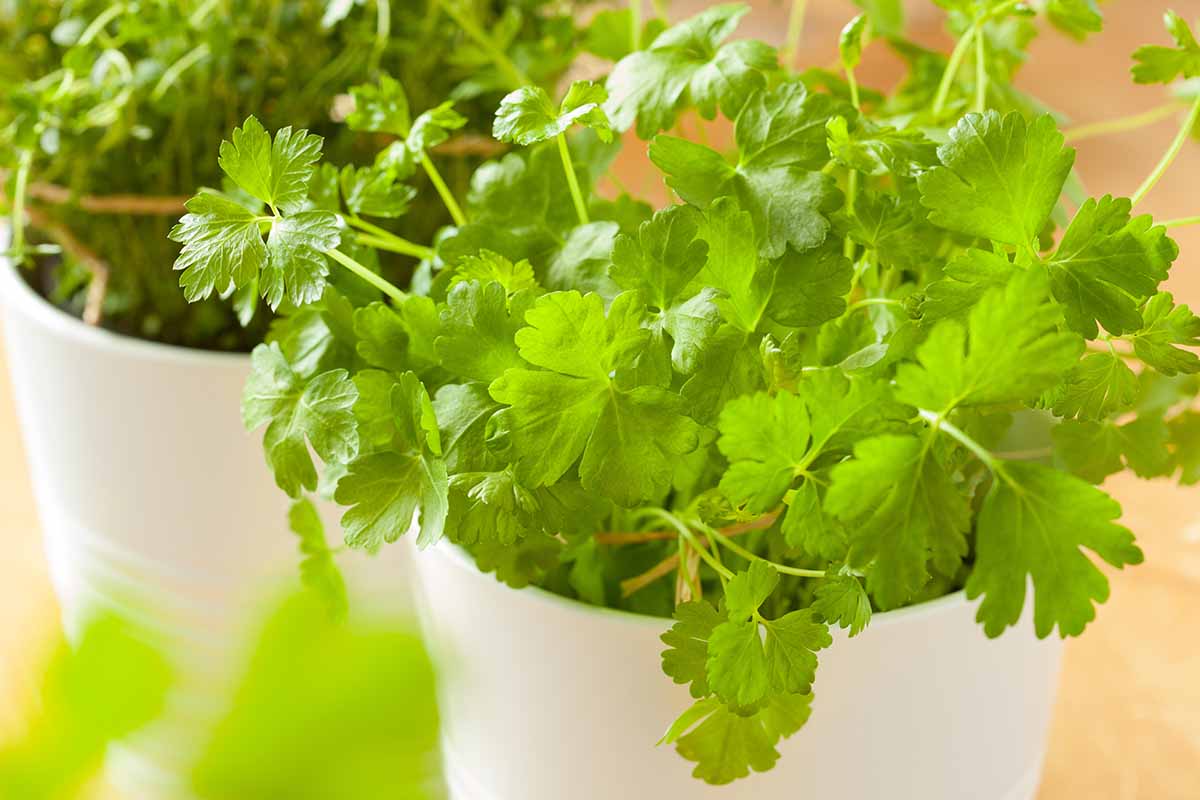
In addition to its use as a food and medicinal plant, coriander makes a great companion plant for other garden crops like marigolds, beans, and kale.
Want to learn more about the scientifically backed benefits of companion planting? Read our article!
One of the reasons cilantro is such a popular companion plant is that it is wonderful for attracting pollinators. In fact, it’s even considered an excellent floral crop to grow for forage for honey bees.
In addition to honey bees, cilantro attracts a wide range of beneficial insects like other types of bees, butterflies, wasps, and hoverflies.

Grown as an annual in USDA Hardiness Zones 2 to 11, this herb is quite adaptable to different growing setups.
Cilantro is easy to grow indoors, and it’s an herb that can be grown in a greenhouse.
You might consider growing coriander in a container, in a raised bed, or cultivating it for its flowers as part of a cut flower garden.
When used in flower arrangements, coriander inflorescences can be used as a filler, taking the place of baby’s breath.
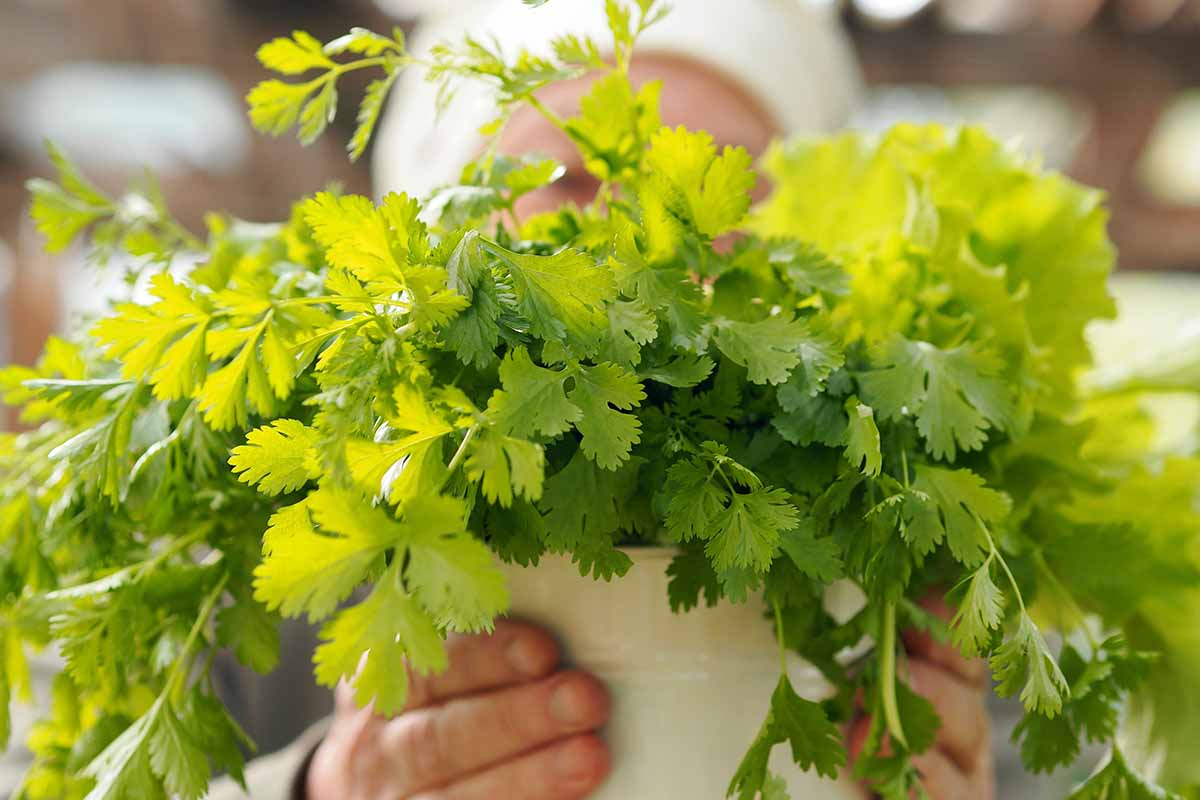
And now, we finally arrive at the burning question – why do some people think cilantro tastes like soap?
It’s all got to do with genetics.
Because of a genetic variation, those of you who hate this herb are smelling and tasting something that the rest of us are not!
Coriander Plant Propagation
This herb is a cool-season crop. If you want fresh leaves to enjoy, plant cilantro in spring, late summer, or early fall for the best results.
However, if you want to grow coriander plants for seeds or for flowers to attract pollinators, it’s fine to plant it during the summer as well.
This herb is extremely easy to propagate from seed, but you can also use transplants that are homegrown or purchased from a nursery. Let’s look at how to accomplish each method, starting with direct sowing outdoors:
From Seed Sown Outdoors
When direct sowing coriander outdoors, sow seeds six to eight weeks before your last average frost date. Germination is best when the soil temperature is between 55 and 68°F.
Cilantro is often grown densely when cultivated for its fresh leaves, or with more space between plants when grown for seeds.
For the leaves, you can plant coriander seeds as close as three inches apart, but it is more commonly grown six to eight inches apart.
For seed production, sow seeds 12 inches apart. In square foot gardening, this herb is grown in the center of a one-foot square.
When it comes to depth of sowing, sow coriander seeds one-quarter to one-half of an inch deep, and water in after sowing.
Keep the growing medium moist but not soggy while seeds germinate – a process which can take up to 21 days.
Keep young coriander plants well-watered, irrigating if needed, until they are about four inches tall. At that point you can reduce watering to about one inch a week.
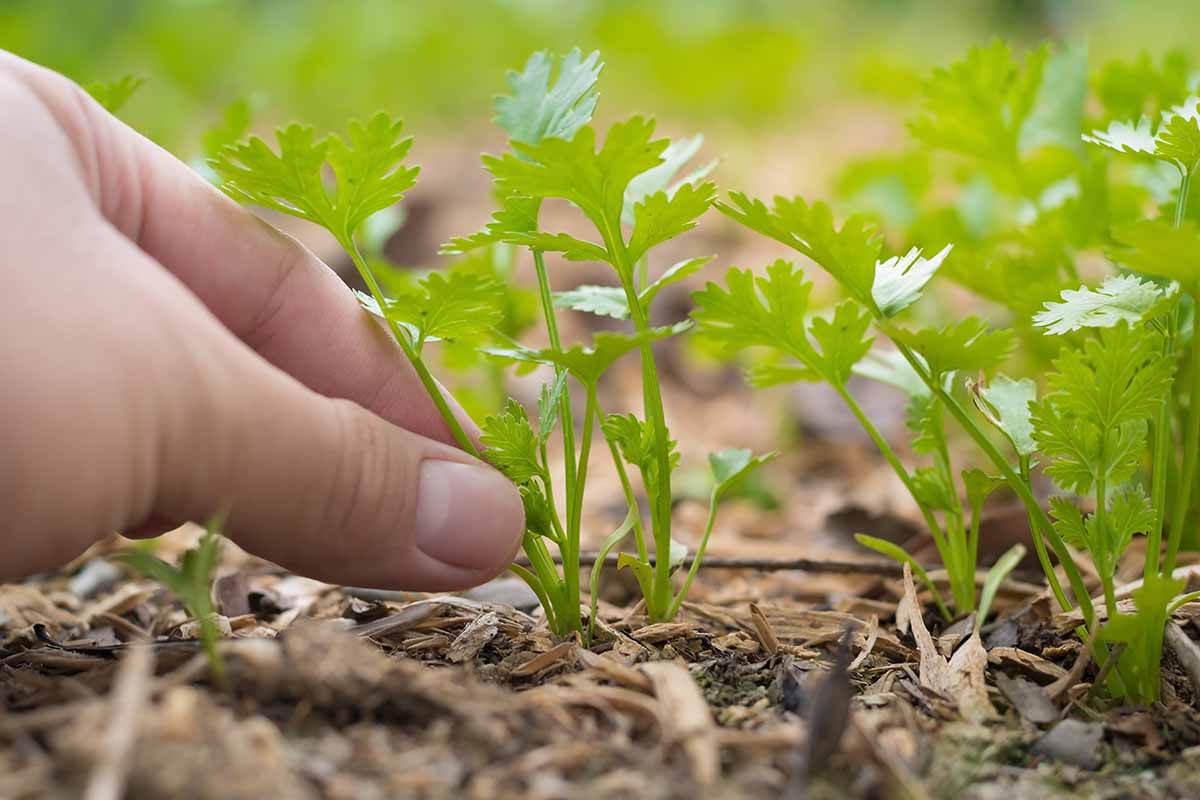
When planted densely, young coriander seedlings can be thinned if needed, and enjoyed as part of an early spring harvest.
For a constant supply of fresh herbs, these seeds can be sown in succession every two to three weeks.
From Seed Sown Indoors
When starting cilantro indoors, sow seeds six to eight weeks before the last average frost date.
Use biodegradable pots such as Cowpots to make transplanting less stressful on plants. Cilantro has a long taproot, and can be somewhat more difficult to transplant from plastic pots.
You’ll find a 12-pack of three-inch Cowpots available for purchase from Arbico Organics.
Fill pots with a seed-starting medium, such as Tank’s Pro Lite Seeding and Potting Mix.

Tank’s Pro Lite Seeding and Potting Mix
This seed-starting medium contains compost, coconut coir, and perlite – you’ll find it from Tank’s Green Stuff via Amazon.
Sow a single coriander seed in the center of a three-inch pot, covering with a quarter to half an inch of growing medium.
When sowing indoors, keep the soil temperature at 55 to 68°F, and expose plants to full sun.
Keep the growing medium moist while seeds germinate, but take care not to waterlog the soil. This can be achieved by watering with a spray bottle at this stage.
Once coriander seeds have germinated, transition to watering with a houseplant watering can.
From Transplants
Once you have a cilantro plant growing in a nursery pot, you will want to transfer it to your garden, a raised bed, or a larger container.
Before transplanting, be aware that coriander seedlings grown indoors will be more tender than seeds sown directly in the soil, and will need to be hardened off.
You can learn more about growing annual plants indoors and hardening them off in our article.
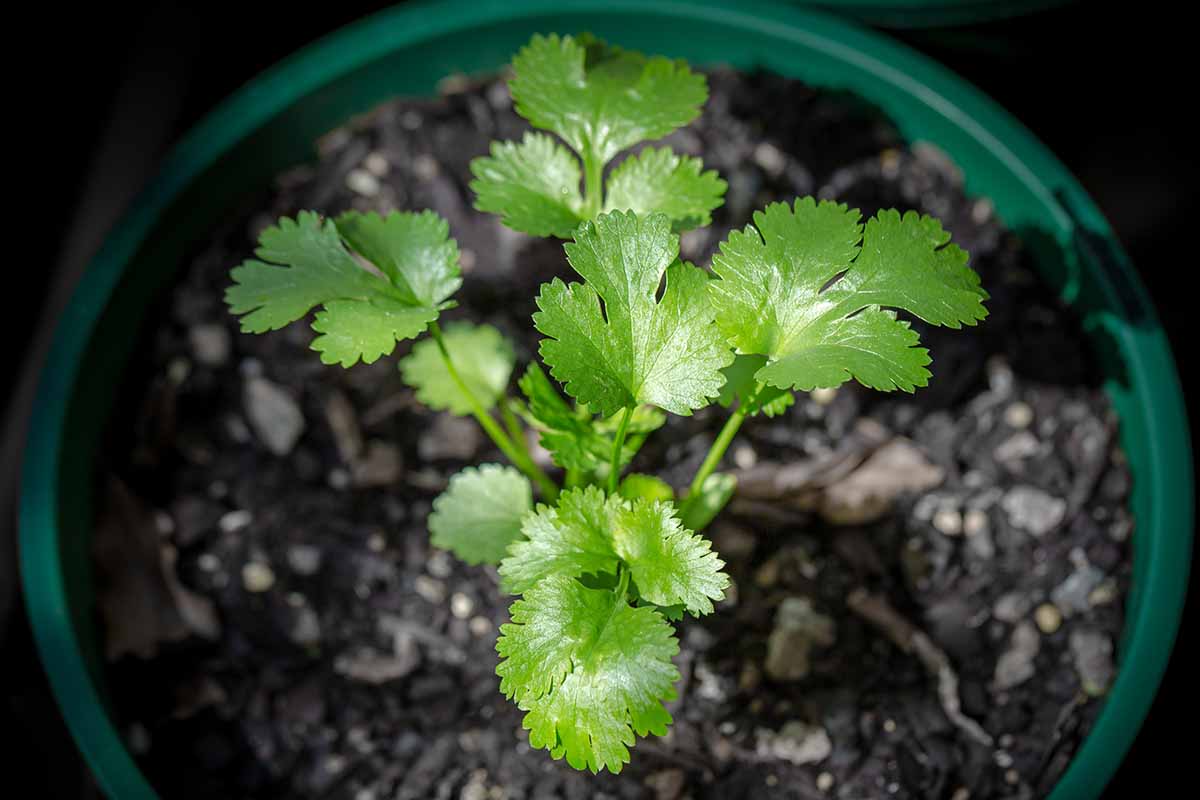
Since cilantro has a delicate taproot, handle transplants gently.
To transplant coriander starts grown in biodegradable pots, break the rim of the pot off before planting it.
For those grown in plastic pots, gently squeeze the sides of the pot, then tilt the plant upside down to release it from its pot – don’t pull on the plant’s stem to remove it.
If the coriander specimen was rootbound in its plastic pot, gently rub your hand along the sides of the roots to loosen them up.

Place the transplant into a hole roughly as deep and twice as wide as the root ball, taking care not to bury the plant’s crown, and backfill with soil.
Water the plant in after transplanting.
How to Grow Coriander Plants
Clearly, cilantro can grow without too much help since it will readily self-seed year after year if seed heads are not removed from plants.
Nonetheless, here are some tips for growing cilantro in the garden that will be helpful for when you’re first getting started:
In cool weather, it’s best to grow cilantro in full sun. But if you have a location that gets morning sun and light afternoon shade, that’s also suitable.
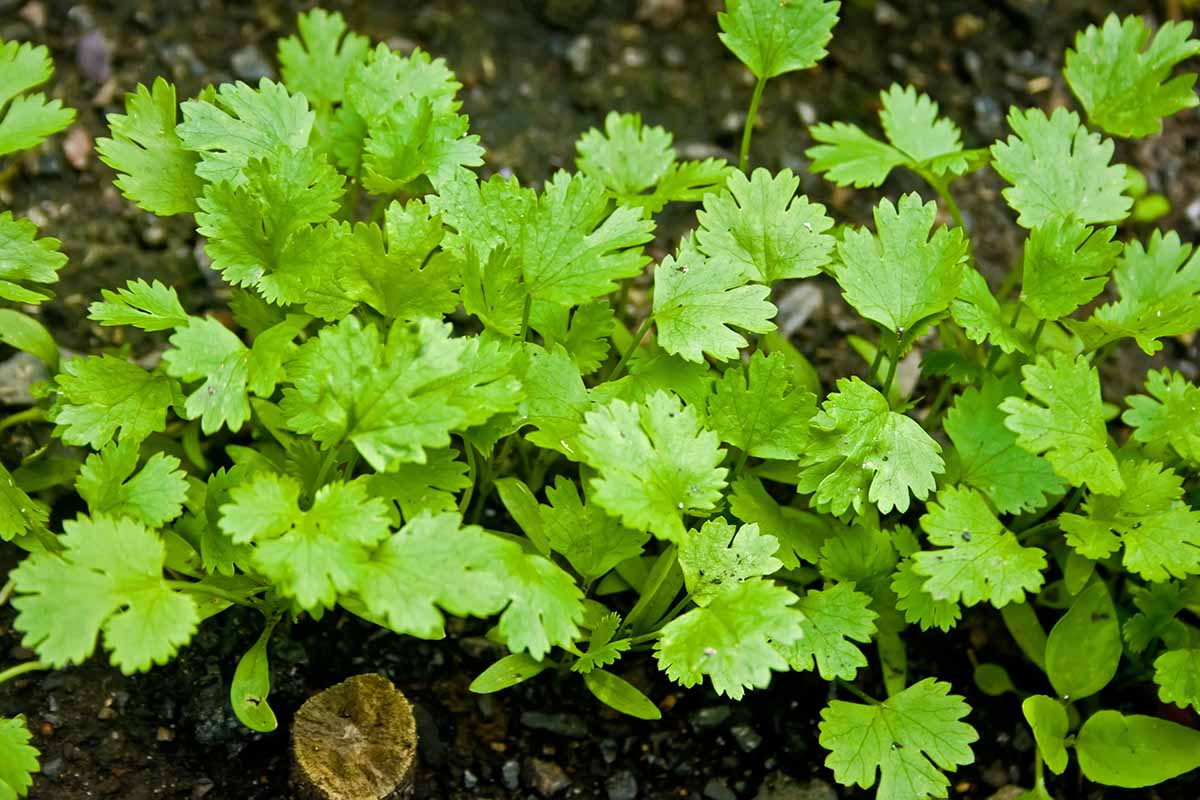
To prevent bolting in the heat of midsummer, this herb can be grown in part shade.
While loam is the garden soil of choice for coriander, it can be grown in a wide range of soils, as long as there is good drainage, plenty of organic matter, and a pH of 6.0 to 7.0.
As for water, young seedlings need to stay well-hydrated, but once plants are established, they are fairly drought tolerant.
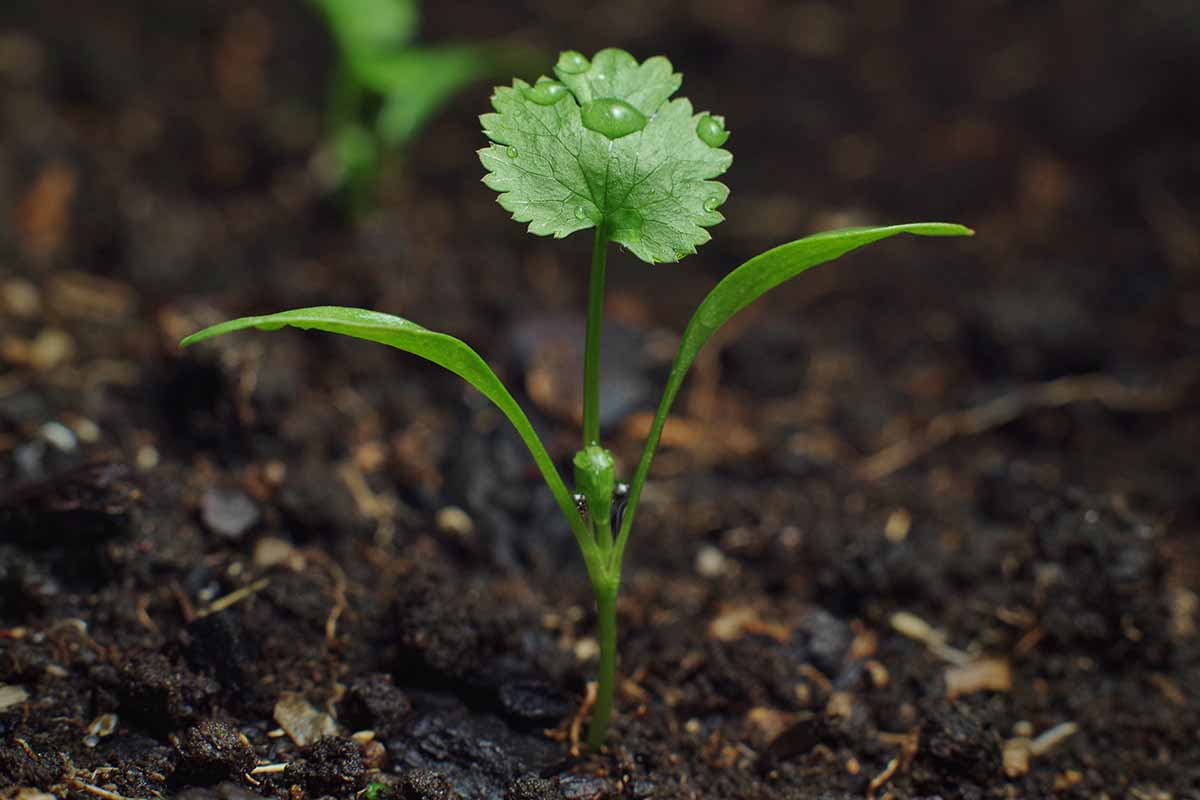
Cilantro plants need about an inch of water a week, more during very hot spells.
This herb grows best at temperatures between 50 and 85°F, but coriander plants can withstand lows down to 10°F.
On the other hand, when temperatures exceed 85°F, coriander will bolt more quickly, so sow some seeds where they will be exposed to light shade during the heat of the day for a continual supply of fresh leaves.
Growing Tips
- Grow coriander in full sun to part shade.
- Make sure the soil drains well.
- Provide one inch of water per week when rain is lacking, more during droughts.
Maintenance
Cilantro is an easy-going member of the garden community and it doesn’t require much upkeep. Here’s what you’ll want to know:
Young seedlings are susceptible to being crowded out by neighboring weeds, so make sure to keep the area weed free until plants get established.
If you need tips on how to spend less time weeding, read our article!
To help prevent weeds from growing around your herb crop, put a layer of mulch around seedlings, leaving an unmulched ring about one inch wide around the stem of the plant.
This will help ensure adequate airflow around the coriander plant and prevent problems with diseases.
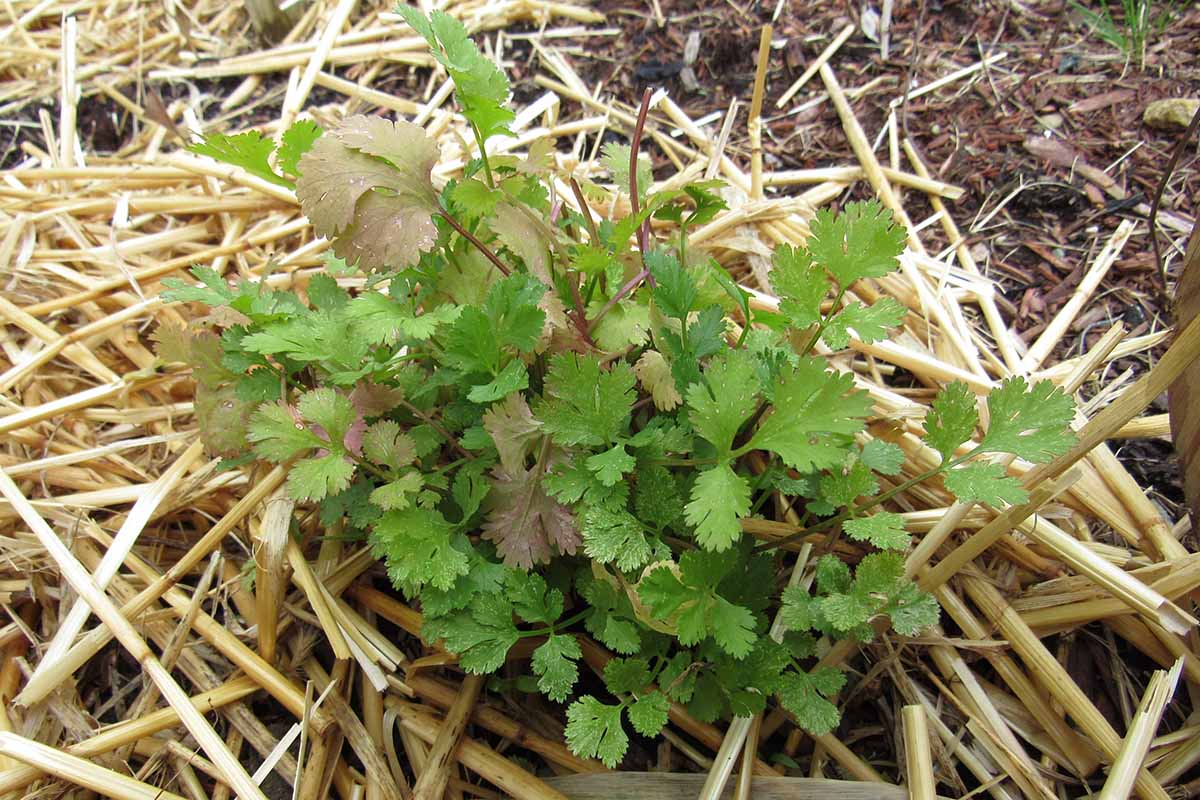
If you add compost when you’re preparing your garden beds, you won’t need to do any additional fertilizing during the growing season.
Add two to four inches of compost into the soil before planting coriander. If sowing a succession of seeds, add more compost at the time of sowing.
Take care not to over-fertilize, however, because too much nitrogen can make the plant less flavorful.
To slow cilantro plants from bolting, provide mulch and water regularly to help keep soil temperatures low, and sow when the weather is cool.
Finally, there is one more maintenance task you’ll want to be aware of when you grow cilantro – that’s dealing with or preventing volunteers.
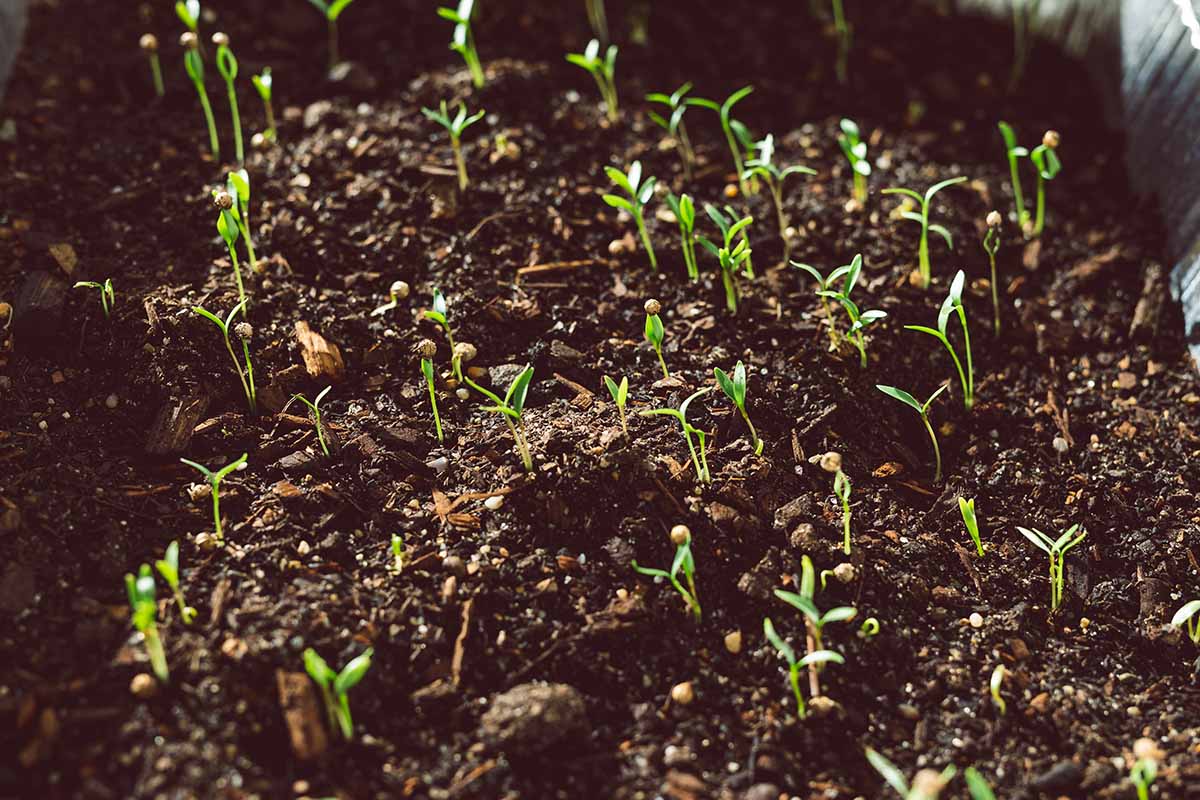
If you plant this herb in your garden and let the flowers go to seed, you’ll have a new crop of cilantro before you know it – either the following spring, or maybe even in autumn, right after your current crop.
Some of us might welcome such easily obtained garden plants – but to prevent these coriander babies from springing up unwanted, make sure to prune off seed heads while they are still immature and green.

If you miss a chance to prune the unripe seeds of coriander plants and you end up with a crop of unwanted volunteers, feel free to harvest them and use them as a garnish, or let them grow into new plants.
Cilantro Cultivars to Select
Ready to get some coriander plants growing?
Though you’ll often find nursery-grown transplants and seed packets marked with a generic label, there are actually many different cultivars available today. These include:
Caribe
‘Caribe’ is an open-pollinated coriander variety known for its vigorous plants bearing dark green leaves on thin stems.
This cultivar is slow to bolt – even slower than the well-known, long-standing variety, ‘Santo.’
‘Caribe’ is great for greenhouse growing and produces a harvest of tasty leaves in 55 days.
Get ‘Caribe’ seed in an assortment of package sizes, ranging from one-eighth of an ounce to 20 pounds, from High Mowing Organic Seeds.
Cruiser
Open pollinated, ‘Cruiser’ produces tidy plants with an upright growth habit, making this an outstanding coriander choice for growing in containers.
Large, dark green leaves grow on sturdy stems and have excellent flavor, somewhat milder than your average cilantro, even after bolting.
This bolt-resistant variety produces a harvest of leaves in 50 to 55 days, or 120 to 150 days for seeds.
Park this cultivar in your garden – you’ll find ‘Cruiser’ cilantro for purchase in packs of 100 or 200 seeds from Pepper Joe’s via Amazon.
Moroccan
Once you’ve chosen a variety of C. sativum to grow as a fresh garden herb, you may also want to choose one for your pollinator partners – or for producing coriander seeds.
Quick to bolt, ‘Moroccan’ is an open-pollinated variety that’s a great choice for flower and seed production.
This cultivar produces a harvest of fresh leaves in 45 days, and seeds in as little as 100 days.
Find ‘Moroccan’ cilantro available for purchase in four-gram packets containing approximately 270 seeds from Botanical Interests.
Want More Options?
Learn about more varieties in our supplemental guide, “19 of the Best Types of Cilantro.”
Managing Pests and Disease
It’s pretty easy to grow cilantro, and most gardeners may never encounter pest or disease problems with this crop.
As we’ve already seen, cilantro is not on everyone’s favorite food list, and that includes some of our neighboring wildlife.
Luckily for us fans of fresh coriander, though deer and rabbits can sometimes treat our gardens like their own private buffets, they tend to leave this herb alone.
But here’s a quick rundown of potential issues to be aware of, just in case:
Insects
Apart from beneficial insect visitors that adore the nectar of these plants, you won’t often have to deal with insect pests on your coriander crop.
However, weakened cilantro plants in particular are more susceptible to insect pest attacks. Here are a few culprits you’ll want to keep an eye out for:
Aphids
If you notice the foliage of your coriander plants turning yellow or becoming distorted or stunted, check the bottom sides of the leaves – aphids may be the cause.
Willow carrot aphids (Cavariella aegopodii) in particular can be a problem on cilantro.
These tiny insects suck nutrients from plant tissues, weakening them. They also leave trails of waste matter in their wake called “honeydew,” which can encourage the growth of fungal pathogens like sooty mold.
If aphids are making a meal of your herbs, they can often be removed with a strong jet of water from the garden hose.
Planting your coriander crops in a polyculture style with a mix of plants from different families in each growing area will help to reduce the presence of pests like aphids, as this type of gardening will increase the presence of helpful beneficial insects such as parasitoid wasps.
Some of these wasps target aphids, so if you do have a batch of aphids on a coriander plant, check for individuals that are bloated and discolored – these have already been parasitized, and you should leave them be. The wasps will do their job controlling these pests.
Learn more about controlling aphids in our article.
Cutworms
Have you ever admired your young crop of coriander seedlings, only to return the next day and find that some of them have vanished?
Cutworms were likely to blame for their disappearance.
These caterpillars tend to spend their days in the top layer of the soil. Emerging at night to feed, they often sever the stems of young seedlings.
While preparing your garden soil in the spring, if you happen upon a cutworm or two, they make a nice treat for neighboring wild birds, such as robins looking for food for their young.
There are ways to protect young seedlings from cutworms – learn more in our article.
Root-Knot Nematodes
Not to be confused with beneficial nematodes, root-knot nematodes are microscopic worm-like organisms that form galls on plant roots.
Signs that these organisms are attacking crops include coriander plants which have lost vigor or are turning yellow and wilting in hot weather.
Learn more about dealing with root-knot nematodes in our article.
Disease
These are some of the most common diseases to look out for on C. sativum:
Bacterial Leaf Spot
Have you noticed small, water-soaked spots on the foliage of your coriander crop?
Lesions caused by bacterial leaf spot, a type of bacterial disease which also affects turnips, will look tan or brown, changing to black and eventually becoming dry and papery.
This bacteria is transmitted from infected seed and then transferred to healthy foliage via splashing water.
Overhead watering, such as sprinkling, promotes the development of this disease, so water at the base of coriander plants instead.
Choose a resistant cultivar if this has been an issue in the past, and be sure to rotate crops in the same family.
Damping Off
There are few things more exciting than a sprouted coriander seed raising its seed leaves above the soil – but excitement can be quickly replaced with disappointment if damping off takes out the young seedling.
This fungal disease can occur when conditions are too damp or when a non-sterile growing medium is used.
Learn more about damping off in our article.
Powdery Mildew
Have you noticed powdery white or gray spots on your herb’s foliage?
Chances are a disease called “powdery mildew” is affecting your coriander plant.
This fungal disease occurs when conditions are humid but mild, in the 70 to 80°F range.
Luckily, powdery mildew on cilantro is not the end of the line for your herbs – treatment is possible!
There are many homemade and organic remedies for powdery mildew – learn about them in our article!
Harvesting Cilantro Leaves and Coriander Seeds
Cilantro leaves can be harvested at any time you like after the plants begin to grow, but you’ll want to allow seedlings to get established before you pick too many leaves.
A good rule of thumb is not to harvest more than a quarter of the plant’s foliage at one time if you want it to keep producing.
Also, wait a few days between harvests to avoid stressing coriander plants.
A little cilantro goes a long way, so if you want to keep a supply going as long as possible, just harvest it as you need it rather than picking a big bunch at one time.
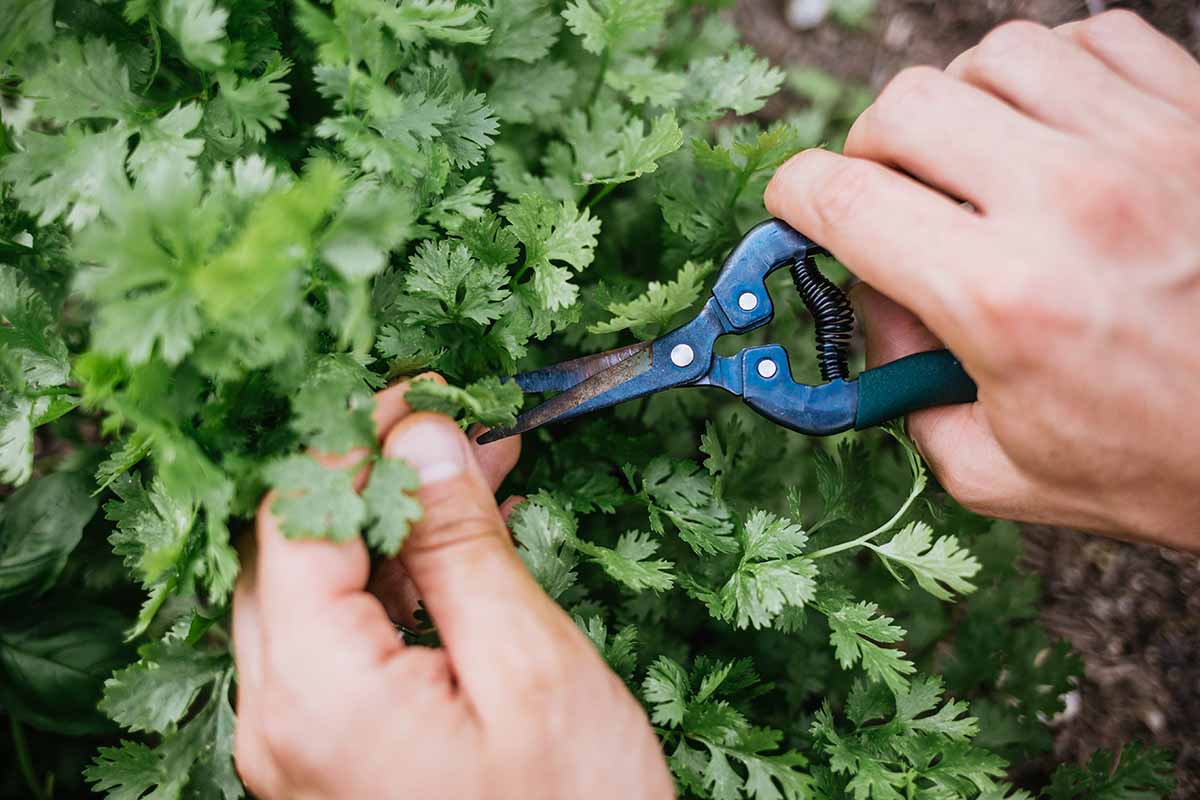
On the other hand, if you do need a lot all at once, wait until the plant is about six inches tall. You can then cut the plant back to a couple of inches tall to allow it to regrow.
Once plants start to bolt, the leaves can start to develop a slightly bitter taste. If you let your plants flower and go to seed, you can harvest the seeds at either of two stages.
Some folks like to use green cilantro seeds in their culinary creations. But for a harvest of coriander spice that will keep in your spice rack, allow the seeds to dry and turn brown on the plant.
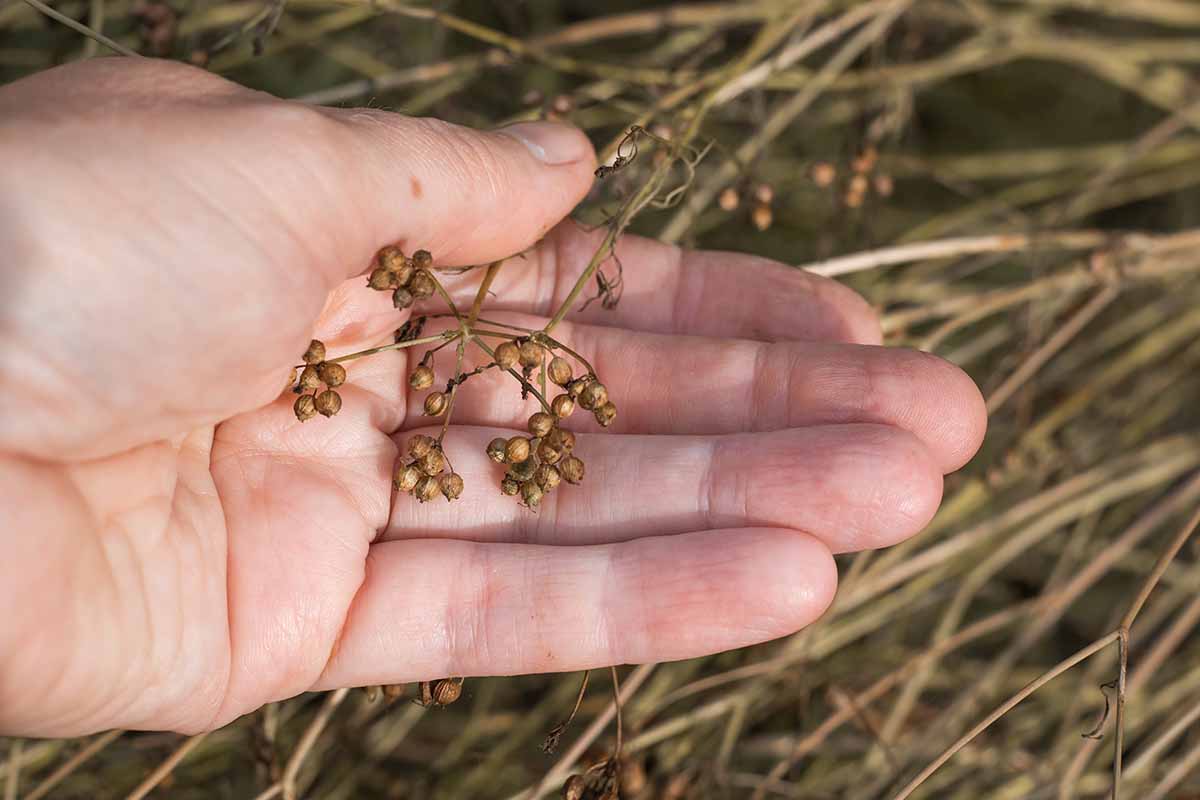
If you prefer to harvest mature coriander seeds, wait until the majority of them turn brown, then cut off the seed heads along with a few inches of stalk and place upside down in a paper bag.
Place the paper bag in a warm, well-ventilated location to allow the seeds to finish drying.
The seeds will eventually finish drying and fall out of the heads into the bottom of the bag. Store them in a lidded glass jar in a cool, dry location.
Storing and Preserving
While picking leaves as you need them is the best plan, when plants start to bolt you may want to harvest more than you can use.
Clean fresh coriander leaves by soaking them in a bowl, then spinning them dry in a salad spinner.
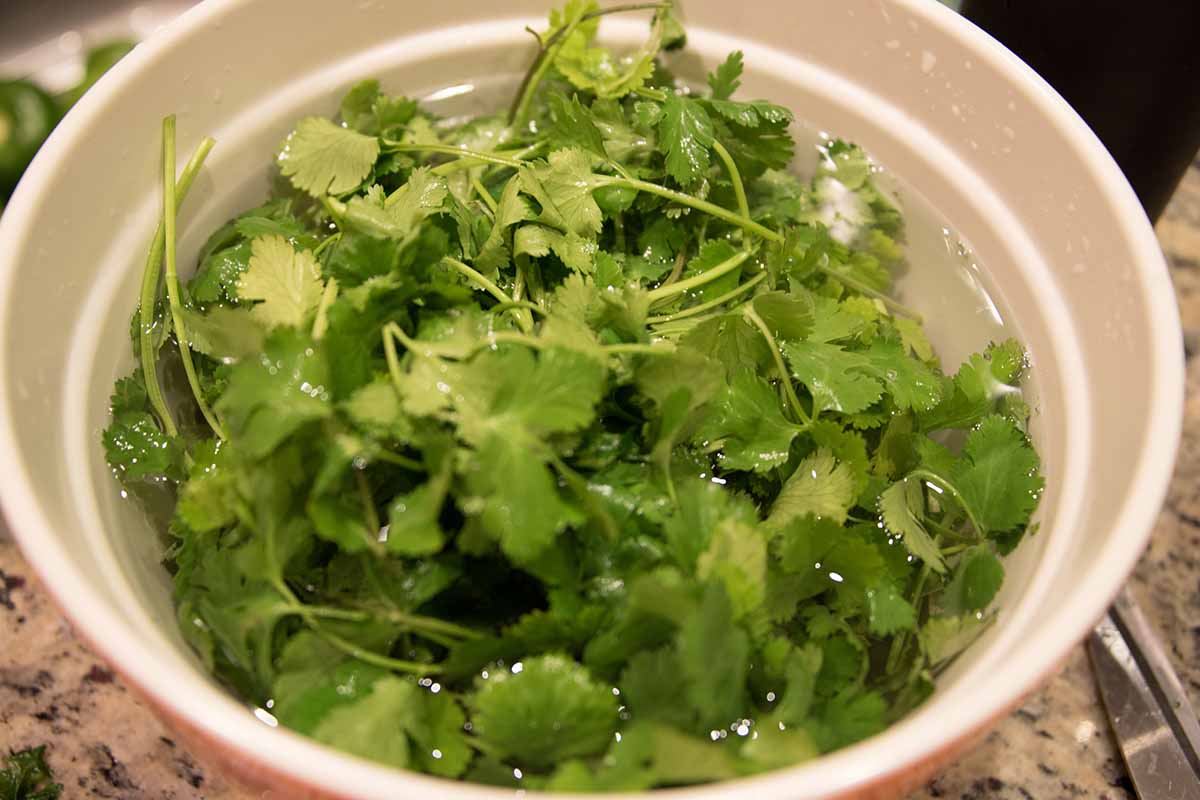
Next, sandwich the dried leaves between two paper towels to absorb excess moisture, and place them (along with the paper towels) in a sealed refrigerator container.
Fresh cilantro will keep in the fridge stored in this manner for one to two weeks.
If you have more than you can use in that amount of time, you may want to preserve the extra, and freezing is the preferred method for longer term storage.
While many herbs can be dried, doing so with fresh coriander will significantly change the flavor of this herb.
Learn how to freeze fresh herbs in our article.
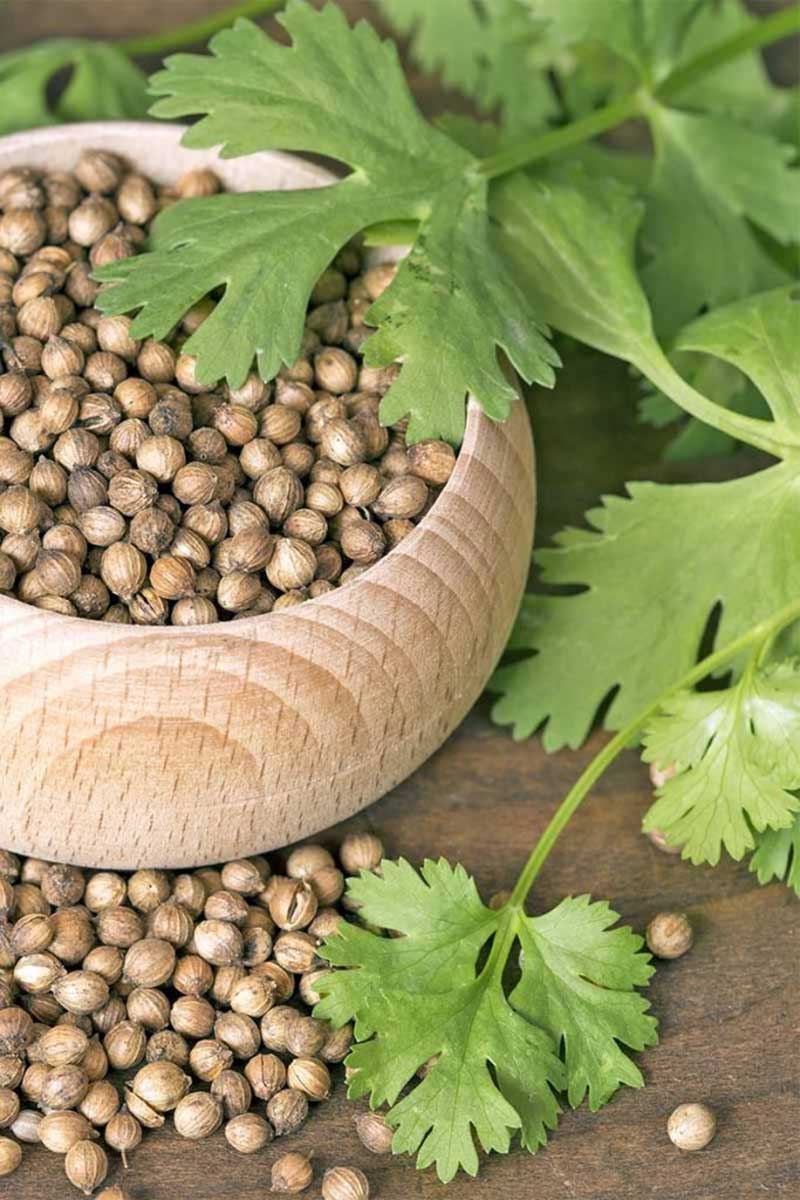
As for coriander seeds, when harvested at the right stage, they can keep their flavor in storage for three to four years.
For maximum flavor, grind the seeds just as you need them.
Recipes and Cooking Ideas
If you’re considering growing cilantro in your garden, I’m guessing you already have plenty of ideas for how you’ll use this culinary herb with your meals – but just in case, let me give you some additional food for thought anyway.
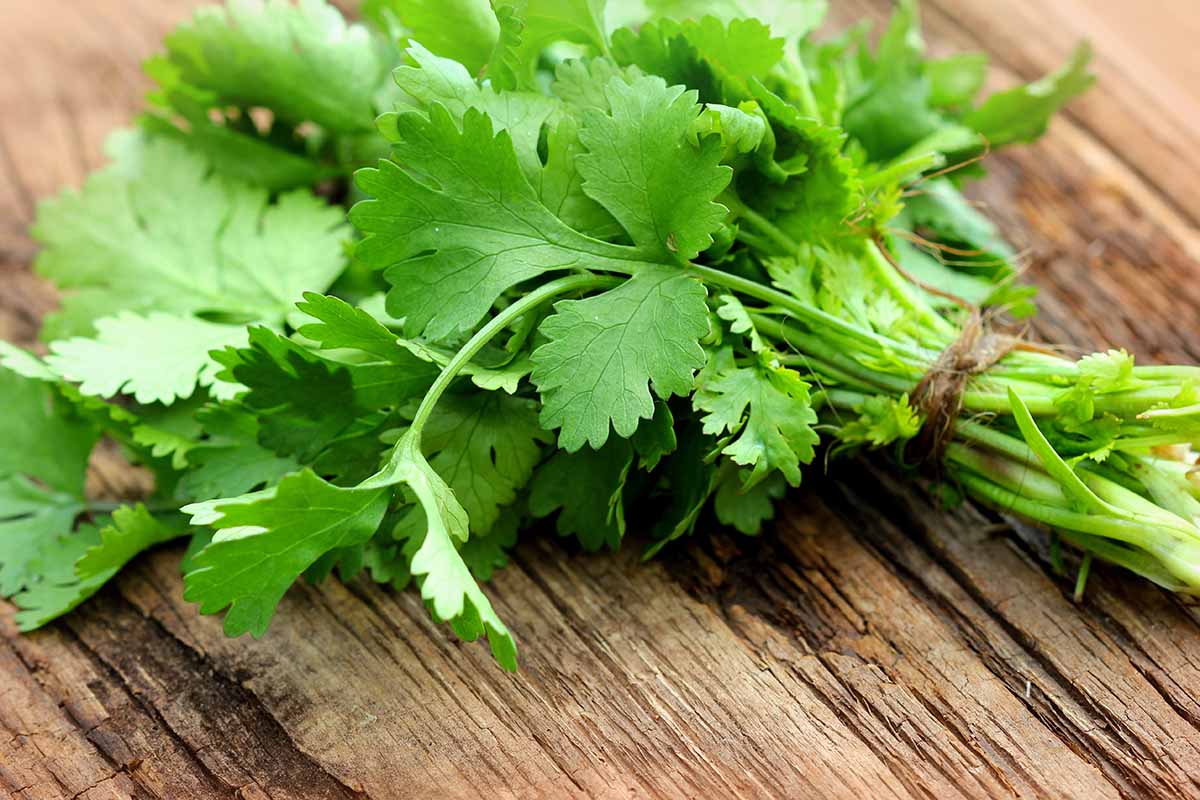
Cilantro can be added to dishes while you’re cooking, but it will impart the most flavor if added fresh just before serving.
As a verified cilantro-head, one of my favorite ways to use coriander leaves when I have plenty growing in the garden is to whip up a batch of cilantro pesto.
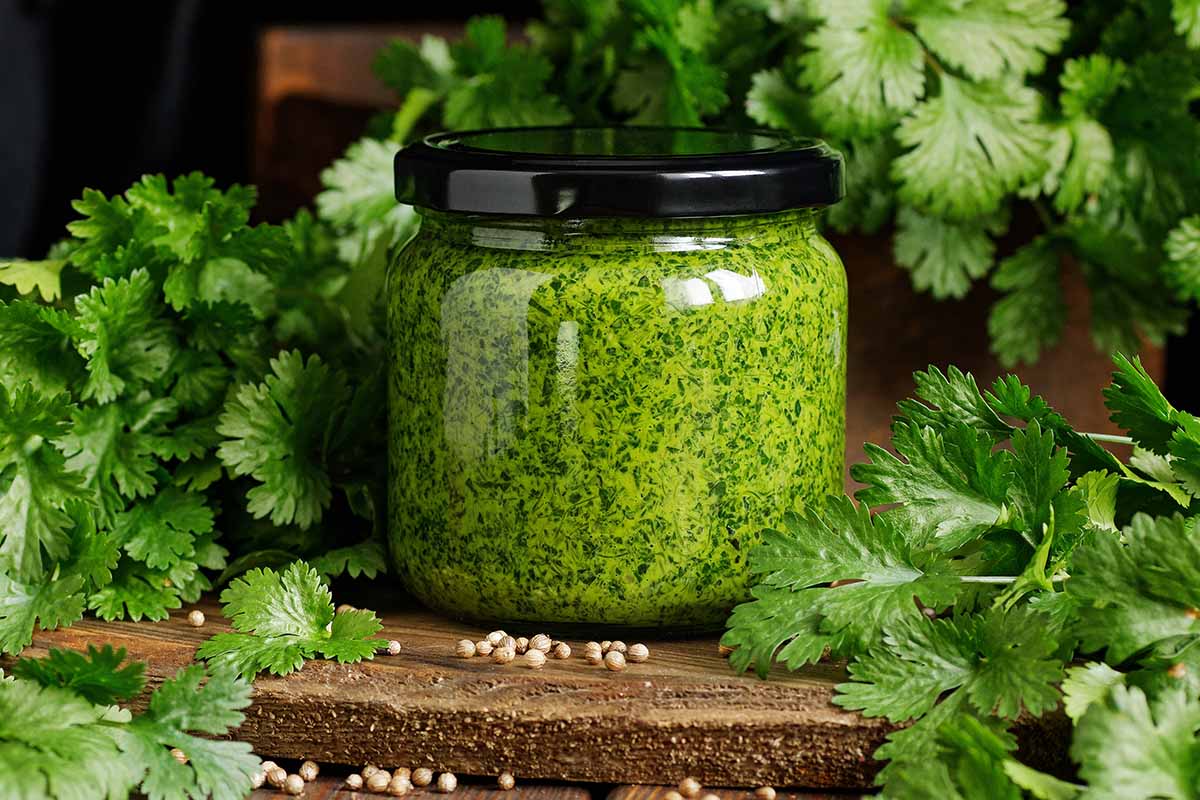
If you’ve ever made a basil pesto from scratch, the idea with this variation is the same, just substitute cilantro for the basil.
I also like to switch out the traditional walnuts or pine nuts for pistachios, and use lime juice instead of lemon juice.
This pesto can be tossed with pasta, stirred into a pureed carrot soup, or used on pizza in place of tomato sauce.
Never made a fresh homemade pesto? No worries, you’ll find a pesto recipe to guide you from our sister site, Foodal.
While this pesto certainly puts cilantro in a starring role, there’s another delicious sauce where it can play an excellent supporting role. That’s in the classic fresh salsa, pico de gallo.

This fresh salsa is simple to make, and it incorporates other ingredients like tomatoes and jalapenos that you may have close at hand growing in your summer veggie garden. You’ll find a recipe for homemade pico de gallo at our sister site, Foodal.
Fresh sauces like pico de gallo seem to have uncountable uses, but sometimes you might want a hardier sauce, like when you’re trying to add a bit of protein to a meal.
Our herbe du jour can also be worked into a tahini sauce that can be drizzled onto falafel, avocado toast, and sweet potato fries, or used as a dressing to take a fresh green salad to a new level of bliss and satisfaction.
Find our recipe for vegan tahini sauce with cayenne on Foodal.
Finally, if you’re looking for a main dish where cilantro can steal the show, why not try this fabulous pumpkin curry?

The bright flavors of cilantro and lime team up to create a beautiful contrast to the earthy sweetness of pumpkin in this dish – which is perfect for serving over a bowl of rice or scooping up with some naan.
You’ll find the recipe for Asian style pumpkin curry on Foodal.
As for coriander seeds, they are a common ingredient in curries, pastries, homemade sausage, and brining or pickling mixes.
Need tips for cooking with this spice? Check out this article on cooking with coriander from Foodal.
Quick Reference Growing Guide
| Plant Type: | Edible herbaceous annual herb | Maintenance: | Low |
| Native to: | Mediterranean, Middle East, Pakistan | Tolerance: | Cold, frost |
| Hardiness (USDA Zones): | 2-11 | Soil Type: | Loam |
| Bloom Time: | Spring, fall | Soil pH: | 6.0-7.0 |
| Exposure: | Full sun to light shade | Soil Drainage: | Well-draining |
| Time to Maturity: | 45-80 days (foliage), 100-150 days (seeds) | Attracts: | Bees, wasps, other beneficial insects and pollinators |
| Spacing: | 3-12 inches | Companion Planting: | Artichokes, beans, bok choy, chard, basil, oregano, eggplant, galangal, kale, lemongrass, lettuce, marigolds, tomatoes, turmeric, zucchini |
| Planting Depth: | 1/4-1/2 inch (seeds); root ball level with soil surface (transplants) | Avoid Planting With: | Fennel |
| Height: | 2-3 feet | Order: | Apiales |
| Spread: | 12-18 inches | Family: | Apiaceae |
| Water Needs: | Low to moderate | Genus: | Coriandrum |
| Common Pests and Disease: | Aphids, armyworms, cabbage loopers, cutworms, leafhoppers, root-knot nematodes; Apium virus Y, aster yellows, bacterial leaf spot, carrot motley dwarf, carrot mottle virus, carrot redleaf virus, cilantro yellow blotch, damping off, fusarium wilt, powdery mildew | Species: | Sativum |
Grow This Glorious Garden Goddess
If you’re a cilantro fan then congratulate yourself – you’ve just learned how to never be without a supply of this divinely addictive stuff! (And if you’re not a fan, then bless you, you must be here to grow this gift of the garden for a loved one.)

Your own homegrown supply of fresh coriander leaves and seeds will always be within arm’s reach from now on.
Are you growing your first crop of cilantro and looking for some help? Are you a lover or a hater of this divisive herb? Cilantro worshipers, do you have any exciting ways to use fresh coriander in the kitchen that you’d like to share with our readers? Let us know in the comments section below!
Now that you’ve satisfied your fresh coriander needs, want to keep reading about growing your own herbs? We have more guides for you right here:
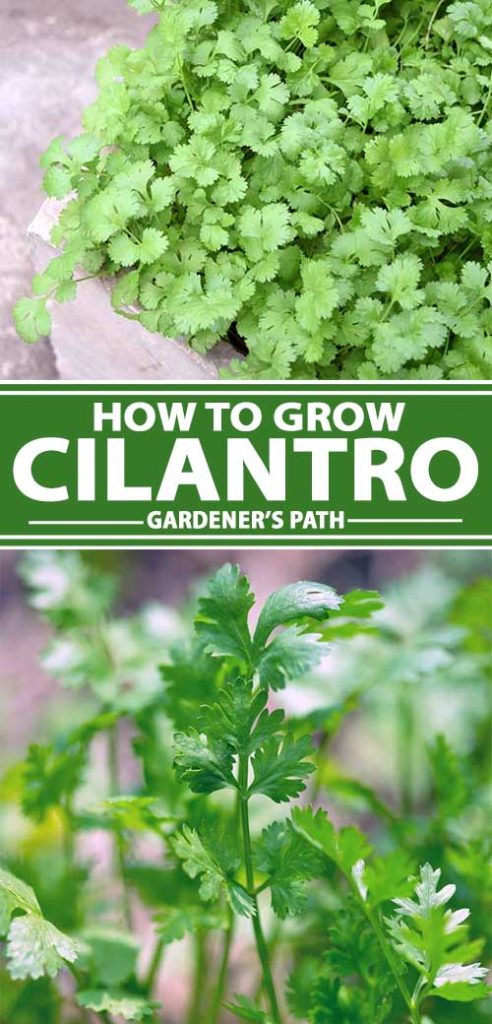
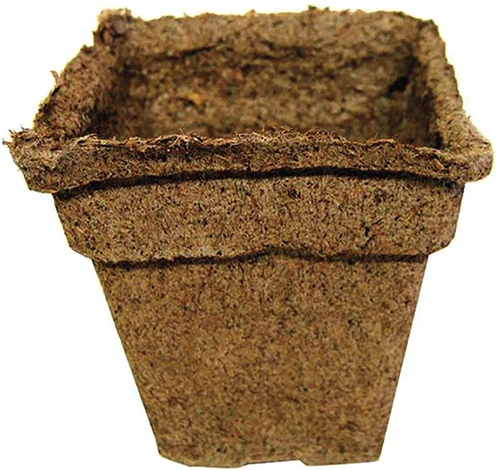
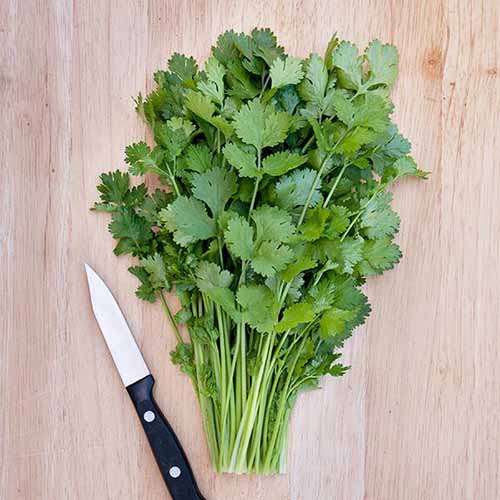

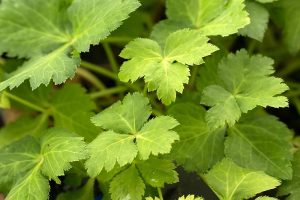
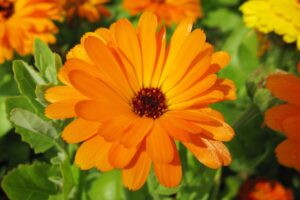
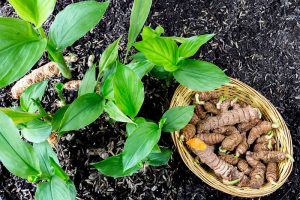
I bought a plant that had already bolted. Some seeds are still green while others are beginning to brown. Can I use either to start new plants right now?
Where are you located, JLR? Depending on the length of your summer growing season, you can go ahead and plant the fully developed and dried seeds to start a new crop. Good luck!
Where will get some to plant in Africa because I’m it will have a different name here
Where in Africa are you located? You may it referred to as coriander or dhania, depending on where you are.
Excellent Guide Thank you. I was wondering, Can we just use Coriander Seeds Grocery Store? Seems like a cheap way to get Cilantro Seeds.
Hi Eric, Thanks for the kind words about this article – I’m glad you found it helpful. And I think you asked a great question! First – coriander seeds sold for spice may or may not be viable seeds. If they have been roasted, they won’t be viable. If you already have a jar of these, you could test them by wrapping a few in a wet paper towel and placing them in a plastic bag. Put the bag in a warmish location (on top of the fridge is a good spot), keep them moist, and check to see if… Read more »